 |
 |
| Chu Home | People | Projects | Publications | Classes | Contact | News & Events |
McMurdo Project Detail: |
McMurdo Project: Campaign at McMurdoIn late 2010, the Chu Research Group landed in McMurdo Antarctica. It took about a month to install and configure the lidar system. We began collecting lidar data in December 2010. Our blog chronicles the week-by-week progress of that effort. Read the McMurdo Lidar Installation blog » Use the link here to access a log showing the hours when data has been collected. This information is updated manually and may not include the latest dates for which we have data. Lidar Data Collection Log [PDF] » Sixth Winter-Over Observations by Ian Barry
Not sure how Ian managed such long runs, but his dedication to the project is unbeatable! It takes great courages to go through the long darkness while keeping one?s spirit up. We wish Ian a great enjoyable time in Antarctica. You are welcome to check on Ian's journals at http://www.southpolescientist.com where he writes his experiences in his own words. Sixth Summer Observations by Ian Barry, Jian Zhao, Xian Lu, and Muzhou Lu
Ian and Xian were joined by the first-year graduate student Muzhou Lu and Dr. Chu (the PI) on Dec. 30, 2015. The lidar team spent the last day of 2015 at the Arrival Heights Lidar Observatory on running the Fe Boltzmann lidar to collect data and welcome the new year 2016! With the great help from Mr. Richard Dean, the team refurbished the lidar instrument including its plumbing system where Ian and Muzhou did a thorough job. We also spent a lot of time on training winter-over scientist and students. Ian and Muzhou made significant progresses over January 2016. After many days and weeks of hard work and extensive training, by 4am when Ian, Muzhou and Xinzhao drove down from Arrival Heights on January 28, 2016, we were really happy because the Fe Boltzmann lidar was in great shape. The lidar status is at least as good as the last two years, and on several aspects it is even better. Ian Barry is very optimistic about winter 2016, and Muzhou Lu has progressed a lot in knowledge and experience with lidar. We are ready for winter 2016! "Chief Ice Barry" will deliver us another exciting winter lidar campaign in Antarctica! Fifth Winter-Over Observations by Jian Zhao
Jian's total data collection of ~1300 hours from late October 2014 through the end of October 2015 is the highest record for single lidar scientist's data collection with the Fe Boltzmann lidar in Antarctica, exceeding all previous years! His âone-personâ show from March through September made several new records. Jian claimed the highest records of 698 h for March through September, 616 h for March through August, and 414 h for May through August, among the last five years. Except a record of 65-h continuous winter lidar data still being held by Cao Chen, Jian has almost claimed everything else, including a 64-h continuous summer lidar run on December 17-19, 2014! We were also deeply impressed by Jian's ability of trouble-shooting the lidar system, overcoming unforeseen difficulties, managing the lidar campaign so balanced over all 12 months, and conducting fruitful science research in the meantime. Here are just a few phrases, but how much he has gone through was incredible!!! Furthermore, diving into the thermospheric Fe/Fe+ modeling, analyzing lidar data, and searching for new topics ⦠Jian has grown into a promising young scientist over the Antarctic experience! The McMurdo lidar data collected in the last five years are extremely valuable. We can proudly say that the McMurdo lidar campaign is a game-changing campaign as it has turned out to be an extraordinary science discovery journey. Many new results from the data have radically changed the generally accepted view of polar upper atmosphere composition, chemistry, neutral wave dynamics, thermodynamics, and electrodynamics. More results and discoveries are awaiting for scientists in the field to make out of the data!!! Fifth Summer Season Observations by Jian Zhao, Cao Chen and Ian Barry
For the first time, Jian had the entire lidar to himself so he was very happy to make some new records out of it. Through the whole November and the majority of December, Jian tried hard to take data on every clear sky opportunity. Finally, he made a new record of continuous 64 hours of lidar data from Dec. 17-20, 2014, which broke the 62-h summer record set by Chris in December 2013. Jian was joined by Dr. Chu and graduate student Ian Barry on Dec. 28, 2014. This was the first-ever Antarctic trip for Ian, and also his first passport trip. Working together the lidar team is refurbishing and upgrading the lidar instrument as well as training new lidar operators. They celebrated the New Year 2015 at Arrival Heights while running the lidar for data. By mid-January, the news came through that both Jian and Ian have PQed for winter. Jian has officially become the winter-over lidar student for winter 2015, and Ian will go for winter 2016. Fourth Winter-Over Observations by Cao Chen
First, Chris claimed both the summer and winter records of the longest lidar run by sole operator in Antarctica â the summer record of 62 hours of continuous lidar data from Dec. 9-12, 2013, and the winter record of 64.5 hours of continuous lidar data from June 28-30, 2014! Of course, people have already known that he was the key member for the 3-person lidar team who made the historic record of continuous lidar run for 174 hours from Dec. 29, 2013 to Jan. 6, 2014 in Antarctica! Furthermore, from May 20 through June 30, 2014, Chris made several times of long lidar runs and the data begin to enable studies such as wave-tide interactions, etc. Second, his data records of 376 hours from May through August, of 537 hours from March through August, and of 597 hours from March through September, are the highest among the last fours years of winter-over operations at McMurdo. His total of ~1280 hours of data from late October 2013 to the end of October 2014 was among the highest records for single lidar scientist's data collection with the Fe Boltzmann lidar in Antarctica, comparable to Weichunâs record in 2013. Chris was amazing to draw support from McMurdo Station and Scott Base to assist him in the lidar data collection! Third, we were really amazed by how Chris resolved laser issues in the middle of winter by himself at Arrival Heights! He called Dr. Chu once after midnight in an April night when one of the SHG windows was broken. After they went through diagnosis and repair via Skype, he went on to take the entire lidar on his shoulder. When a few more serious problems occurred in late May 2014, Chris did the trouble-shooting and repair by himself alone! Such fantastic laser work enabled the long runs of lidar data, and his data gave the highest signal levels in the last four years. Fourth Summer Season Observations by Cao Chen, Weichun Fong and Jian Zhao
Chris became the lidar 'chief' and managed to collect a large amount of data in the summer by himself. In particular, he ran the lidar for continuous 62-hour data collection in December 2013 – a new record in Antarctica! These data are invaluable to the studies of polar summer mesosphere and lower thermosphere. Dr. Chu and Jian Zhao (a first-year PhD student) joined Chris on December 23rd, 2013. This was the first-ever Antarctic trip for Jian. Working together the lidar team refurbished the Fe Boltzmann lidar and further upgraded it with two new receiver choppers that were made by PhD student John A. Smith. The lidar team made a record-setting lidar run when 2013 was turning into 2014! An unusual Antarctic warmth with continuous clear skies from near the end of year 2013 to early January 2014 provided us a great opportunity to make a new record in lidar history in Antarctica! We did a continuous lidar run of 174 hours at Arrival Heights under blue skies, which was from 11:30pm on Dec. 29th, 2013 to 5:30am on Jan. 6th, 2014 (McMurdo local time). This record was achieved with three lidar team members: Cao Chen (Chris), Jian Zhao, and Xinzhao. Two PhD students Chris and Jian from CU-Boulder have done superb jobs! Seven days plus extra six hours of continuous Fe lidar observations for middle and upper atmosphere studies in Antarctica -- such a lidar marathon record is probably very hard to break! It was also why we gave a title of "LIDAR Marathon" to the Sunday science lecture on Jan. 19, 2014 at McMurdo. The lidar data are precious because they provide the first opportunity to study how the physical, chemical and dynamical characteristics of the stratosphere, mesosphere and lower thermosphere vary through multiple days at such a high-latitude site like McMurdo. Chris and Jian carried the lidar observations through the 4th summer season until late February 2014. During the lidar marathon run, we learned that Chris passed all tests and officially became the 4th winter-over lidar scientist at McMurdo! Congratulations to Chris! Third Winter-Over Observations by Weichun Fong
During the 14 months of Antarctic deployment from late August 2012 to the end of October 2013, Weichun Fong has made several new lidar records: 1) Weichun's lidar measurements on June 1st, 2013 set the highest altitude record of lidar detection to date -- neutral Fe layers up to 170 km in the thermosphere. Such a science discovery has opened the door for whole atmosphere lidar. 2) The total of ~1250 hours of data from September 2012 to the end of October 2013 made the new record for single lidar scientist's data collection with the Fe Boltzmann lidar in Antarctica. Another achievement of Weichun was that while working in Antarctica, he managed to complete a paper on the studies of McMurdo temperature tides, and now the paper has been published in Journal of Geophysical Research – Atmosphere. A new discovery by this paper is the super-exponential fast growth of temperature tidal amplitude above 100 km. Third Summer Season Observations by Weichun Fong, Brendan Roberts and Cao Chen
After several days of flight delay in Christchurch, New Zealand, Dr. Chu finally flew in McMurdo on December 23rd, 2012, where she found both Weichun and Chris were very enthusiastic about the lidar observations and they were anxiously waiting for the sky to clear up. Working with Weichun and Chris, Dr. Chu inspected the second harmonic generators of two pulsed alexandrite lasers (PALs) and significantly improved the frequency doubling efficiencies (reaching 40%) for both channels. They also upgraded the pump chambers of both PALs, and optimized the injection seed lasers and injection coupling inside PALs. All these activities led to the significant improvements of performance of the Fe Boltzmann lidar transmitter. Plus the re-alignment of the 372nm channel receiver by Weichun earlier, the lidar team significantly increased the lidar return signals that helped the summer observations under full sunlight. Weichun and Chris got good opportunities to practice the laser work with Dr. Chu, and both became very confident with the lidar system. By January 16, 2013 -- the day Dr. Chu flew out of the ice, the Fe lidar had reached its best performance and the lidar team had caught several more extreme Fe events during the 3rd summer observations. Another good news came one day later -- Weichun and Chris passed all tests, and Weichun officially became the 3rd winter-over lidar scientist at McMurdo! Congratulations to Weichun! In this 3rd summer season, the lidar team received very valuable help from Richard Dean who gave us good hands in repairing water leakage and power failure. Furthermore, he also showed two PhD students how to handle various engineering problems in the real world. Many thanks to Richard! Second Winter-Over Observations by Brendan Roberts
Second Summer Season Observations by Wentao Huang, Brendan Roberts and Zhibin Yu
First Winter-Over Observations by Zhibin Yu
First Summer Season Lidar Team: Xinzhao Chu, Chester S. Gardner, Wentao Huang, Weichun Fong, Zhibin Yu, John A. Smith, and Zhangjun Wang
Alongside Dr. Chu, Research Scientist Wentao Huang, PhD students Weichun Fong, Zhibin Yu, and John A. Smith traveled to McMurdo for the lidar installation and first season observations. Former PhD student Zhangjun Wang provided computer technical support from Qingdao. Dr. Gardner joined the crew at McMurdo in mid-January 2011 for approximately two weeks. More details were given in the McMurdo Lidar Installation blog. |
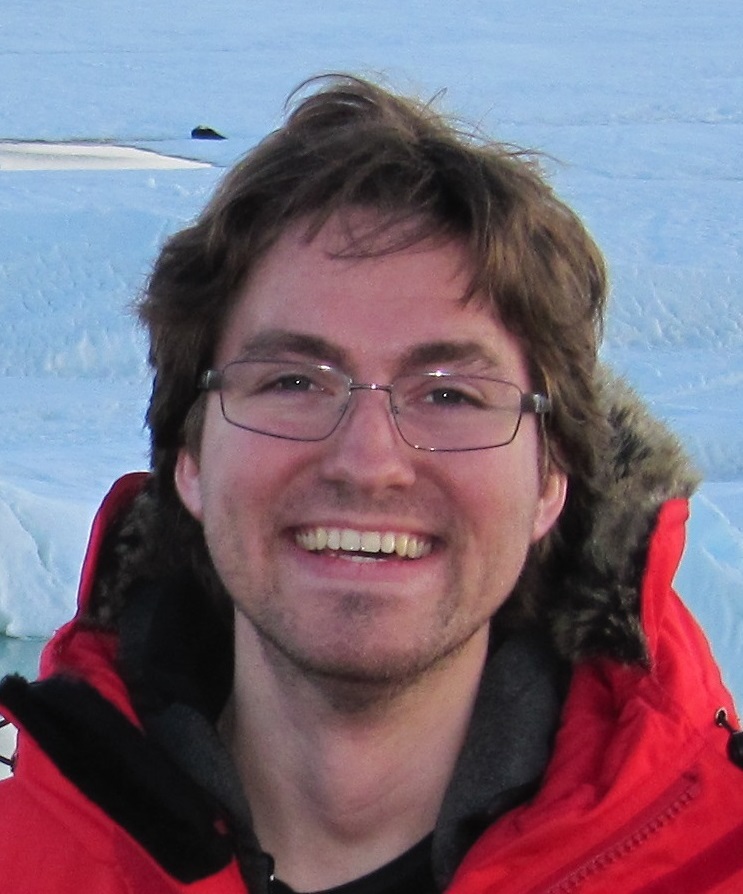





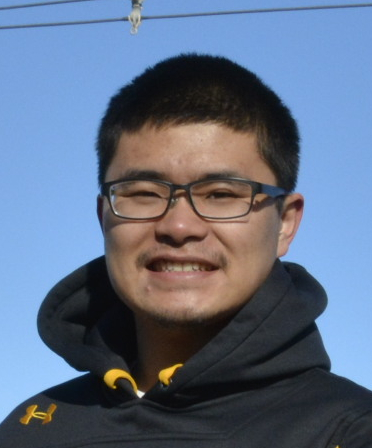

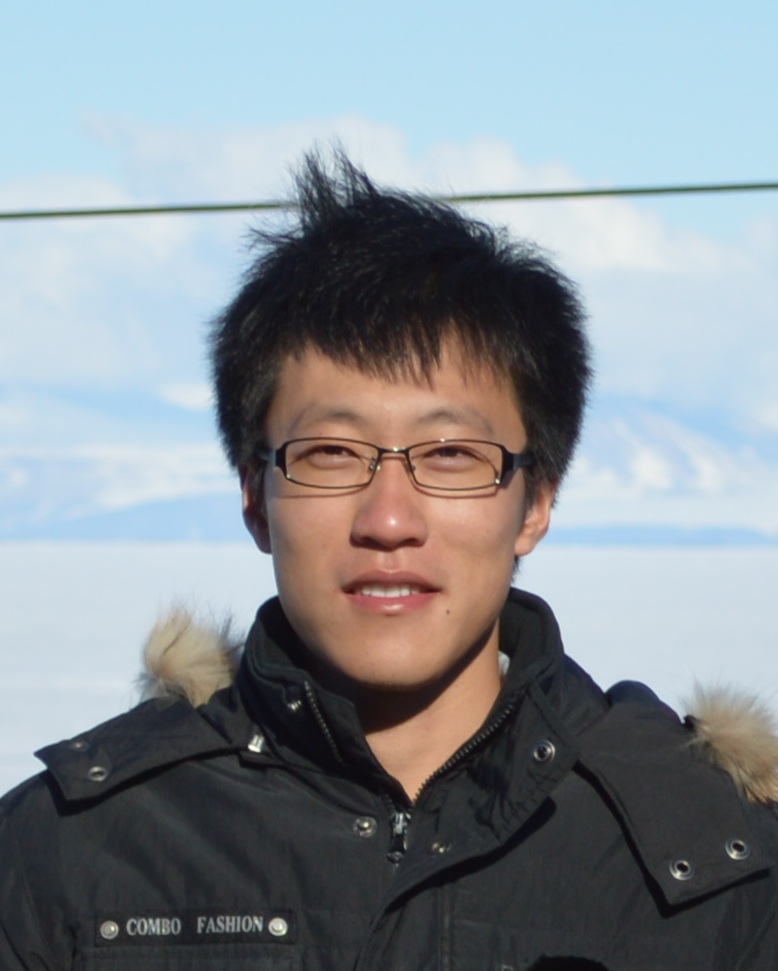
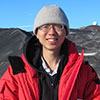


 PhD student Weichun Fong flew in McMurdo on August 23rd, 2012 by the winter flight (WINFLY). This is the first-ever winter flight for the lidar team members. The huge contrast between Boulder's hot summer and McMurdo's chilly winter posed a big challenge, but Weichun handled it nicely. He joined the winter-over lidar engineer Brendan Roberts for the Fe Boltzmann lidar observations. They further performed calibration, optimization and maintenance of the lidar system. These two members did a nearly 70 hours of continuous lidar observations from 15-18 October 2012. PhD student Cao (Chris) Chen arrived in McMurdo on October 22nd, 2012 and joined in the summer observational team. Brendan finished his one-year work on the ice by mid-November 2012 and flew home just before the Thanksgiving holidays. Weichun and Chris carried the lidar observations through the 3rd summer season until late February 2013.
PhD student Weichun Fong flew in McMurdo on August 23rd, 2012 by the winter flight (WINFLY). This is the first-ever winter flight for the lidar team members. The huge contrast between Boulder's hot summer and McMurdo's chilly winter posed a big challenge, but Weichun handled it nicely. He joined the winter-over lidar engineer Brendan Roberts for the Fe Boltzmann lidar observations. They further performed calibration, optimization and maintenance of the lidar system. These two members did a nearly 70 hours of continuous lidar observations from 15-18 October 2012. PhD student Cao (Chris) Chen arrived in McMurdo on October 22nd, 2012 and joined in the summer observational team. Brendan finished his one-year work on the ice by mid-November 2012 and flew home just before the Thanksgiving holidays. Weichun and Chris carried the lidar observations through the 3rd summer season until late February 2013. 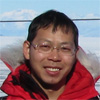
 Research Scientist Wentao Huang flew in McMurdo in mid-October 2011 and worked there for three months to conduct extensive lidar observations in the summer. He made a record of continuous 36 hours of Fe data by single operator in November. A large amount of data was collected with exciting results. Graduate student Brendan Roberts joined in early December for the summer campaigns. By mid-January 2012 when Wentao flew out, PhD student Zhibin Yu arrived in McMurdo for the second time and worked with Brendan to conduct the campaign until late February. Dr. Chu spent four weeks at McMurdo from January 9, 2012 to February 6, 2012. Working with the lidar team, she optimized all four lasers of the Fe Boltzmann lidar system and tuned them to the optimum status for the coming winter. After a summer of training and practice, Brendan was ready for taking over the lidar and braving through the 2nd winter season.
Research Scientist Wentao Huang flew in McMurdo in mid-October 2011 and worked there for three months to conduct extensive lidar observations in the summer. He made a record of continuous 36 hours of Fe data by single operator in November. A large amount of data was collected with exciting results. Graduate student Brendan Roberts joined in early December for the summer campaigns. By mid-January 2012 when Wentao flew out, PhD student Zhibin Yu arrived in McMurdo for the second time and worked with Brendan to conduct the campaign until late February. Dr. Chu spent four weeks at McMurdo from January 9, 2012 to February 6, 2012. Working with the lidar team, she optimized all four lasers of the Fe Boltzmann lidar system and tuned them to the optimum status for the coming winter. After a summer of training and practice, Brendan was ready for taking over the lidar and braving through the 2nd winter season. PhD student Zhibin Yu braved the Antarctic winter to ensure the success of the McMurdo lidar project. Some of his experiences are unique to this demanding environment. His photos show the drama of the landscape and the challenges posed by a mission in such conditions. Visit his blog:
PhD student Zhibin Yu braved the Antarctic winter to ensure the success of the McMurdo lidar project. Some of his experiences are unique to this demanding environment. His photos show the drama of the landscape and the challenges posed by a mission in such conditions. Visit his blog: 

